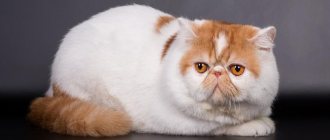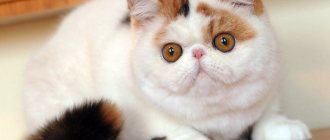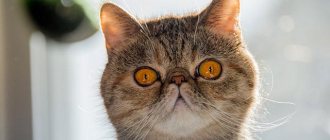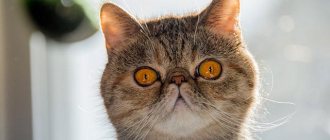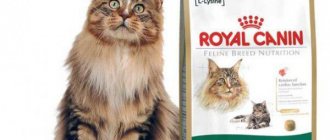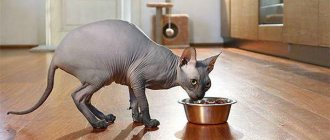Natural exotic nutrition
So, if you have chosen natural food for your exotic, then its main dishes will be meat and dairy products.
All meat dishes are very easy to make. You will need lean, boneless beef, which must first be frozen. When the meat has melted a little, cut it into small pieces (for kittens - 1 by 1 cm, for older cats from 2 to 3 cm). Add half a spoonful of olive oil and a little vegetables here:
- boiled cauliflower;
- boiled beets;
- spinach,
- salad;
- cat grass.
You can add a little cooked buckwheat or rice. We count on 3 parts meat - 1 part porridge and vegetables.
Also discuss with your veterinarian what minerals and vitamins your cat needs and in what quantities. You can add them there too. By the way, there are complex supplements that also contain probiotics that normalize digestion and the intestinal microflora of an exotic cat.
Exot can also include offal in the diet. For example, beef heart will be useful, but it is better to avoid liver, as it may contain parasites. You can sometimes give chicken or turkey, as well as fish (without bones and skin).
For dairy products - 1% kefir, but it’s better to keep it in the refrigerator for 1-2 days, otherwise fresh kefir may make your cat weak. Giving cottage cheese is also useful, but not very fatty - up to 9%. The same goes for yogurt and sour cream (up to 10% fat content) - give it 2 times a week. By the way, it is better to dilute sour cream with boiling water. You can pamper your pet with fermented baked milk, but not too fatty.
As a rule, cats drink fresh milk at a young age, but it can make adult exotic cats weak and bloated.
It is important that in your house or apartment your exotic cat always has access to cat grass, which is very easy to grow from seeds.
Veterinarians recommend taking a urine test while eating exotic foods naturally once every 5-6 months.
The temperature of prepared food should be no more than 40 degrees Celsius.
Diet
You can also use specialized feeds, combining them partially with natural products. As for the diet, exotic kittens up to 3 months are fed 6 times a day, up to six months - 4 times, and after 9 months - 2 times.
If you choose a one-time mode, then eat at night.
It is very important that your cat always has access to clean water. This is regardless of how and what you feed it.
Caloric content of the diet
On average, for one meal it should be 60 kcal per 1 kg of cat’s weight, and up to 400 kcal per day (depending on the weight of the animal).
Natural nutrition
If the option of dry food is not suitable for you for some reason, then representatives of this breed may well eat natural food. But you need to know exactly what to feed your exotic cat. Due to health conditions, the list of products allowed for them is quite small. Under no circumstances should exotic cats be given human food, as the spices, salt and sugar it contains can cause serious harm.
A proper diet should look like this:
- 70% - meat, offal and fish. Boiled lean meat or poultry, chicken hearts, beef lungs and kidneys, and lean fish should make up the lion's share of the daily diet. In this case, fish can be fed once a week or less.
- Porridge. Well-cooked buckwheat and rice are best.
- Vegetables. Lettuce, cauliflower, spinach or beets must be mixed into the porridge so that your pet receives the necessary set of vitamins.
- Dairy products. Low-fat cottage cheese in small quantities won’t hurt either, but you shouldn’t get carried away with it. Kefir needs to sit in the refrigerator for a couple of days to avoid a laxative effect. You can’t feed an exotic cat with milk.
- Vitamin supplements. With a natural diet, it is almost impossible to give the animal all the necessary substances without overfeeding it. Therefore, the lack of vitamins and microelements must be compensated for with special supplements.
The ideal ratio of products in the diet of an exotic breed cat is 3:1. Where 3 is meat products, and 1 is porridge, vegetables and dairy products.
Catering
Like any other kittens, an exotic baby should be near its mother for the first 2-3 months of its life. On her milk he will get stronger and receive everything he needs for development and growth. The first feeding is allowed when the kitten is at least 2 months old. If he actively feeds on mother's milk and gains weight well, complementary feeding can be postponed until 3 months.
The best product in this case will be special dry food. Of course, it will be quite difficult for a cat to chew such food on its own, because he is just learning to do it. Therefore, veterinarians recommend pre-soaking dry food.
If the food is too hard, then cracks and small erosions appear in the animal’s digestive tract. Their appearance may be indicated by small spots of blood in the kitten’s feces. The number of meals directly depends on the age of the animal:
- 2-3 months - 7 times a day;
- 3-4 months - 6 times;
- 5 months - 5 times;
- 5-9 months - 4 times a day.
Kittens from 9 months and adults should eat 2 times a day. It is advisable to maintain the same amount of time between meals and a stable eating schedule.
The animal’s diet should not be monotonous; you can combine both natural products and ready-made dry food or special canned food. However, in no case is it allowed to feed exotic animals with food and dishes “from the master’s table”. Otherwise, the cat will have indigestion.
Regardless of the age of the cat and what diet the owner has chosen for him, an exotic cat should always have access to a bowl of fresh water.
How to feed an exotic kitten
No matter how much you would like it, the kitten should be left next to its mother for 2-3 months so that it can properly grow stronger on its mother’s milk.
Important! Exotic kittens need a balanced diet. It is strictly forbidden to feed them food from the master's table.
The first complementary feeding can be started at 2 months with special dry food, more details here.
The product should first be soaked in water to make it easier for the kitten to chew. Otherwise, microcracks may form in the stomach and intestines. This can be recognized by droplets of blood in the stool.
The following ready-made foods are perfect for feeding small exotics:
- Eukanuba Kitten (wet food for kittens aged 1 to 12 months), Eukanuba Kitten Healthy Start Chicken & Liver (dry food).
- Bosch Sanabelle Kitten (dry food).
- Hill's Science Plan Healthy Development (wet food), Hill's Science Plan Healthy Development (mousse).
Pros and cons of the breed
Like any other breed of cat, Exotic Shorthairs have both advantages and disadvantages.
| pros | Minuses |
| Beautiful exterior | Discharge from nose and eyes |
| Easy to care for | Predisposition to certain diseases |
| Peaceful disposition |
The Exotic Shorthair is an attractive cat that looks like a plush toy. Her unusual appearance combined with her gentle nature and moderately active temperament make her an ideal companion for families with children and single people who spend a lot of time at home.
Habits and character of exotics
Exotics almost completely copied their character from the character of the Persian cat. They received absolutely nothing from their distant ancestors - the independent American Shorthairs. The following epithets are suitable for the special character of these animals:
- Affection and tenderness. Fans of cats call exotic cats the real angels of the cat world and claim that it is impossible to find a more affectionate and gentle animal. They are very obedient and friendly
- Calm. Exotics communicate with people in a very soft and calm tone, and only in rare cases. You can hear a cat's quiet meow only when he really wants something.
- Cheerfulness and energy. Representatives of the breed are very smart, love to explore the world and enjoy it. They enjoy spending time with small children.
Cat plays with a small child
- Caution. Exotic cats are very wary of strangers. Before showing their sympathy to someone, they will look closely at the person for a long time. A cat will decide to approach a stranger only if it likes him.
- Unobtrusiveness. Cats are so reluctant to be intrusive that they can sit at their owner’s feet for hours until the owner invites them to climb onto his lap or pets him himself.
- Devotion. These cats will be devoted to their owner until the end of their lives. They suffer alone and appreciate the attention given to them.
The favorite of this breed is ready to go on a trip with its owner anywhere in the world, just so as not to be separated. They really suffer a lot alone and without the care of their owner. Therefore, the new owner of an exotic cat must perceive such boundless love with understanding and respect, and respond to the pet in the same way.
Shorthaired exotics look like plush toys with sad eyes
Exotics are able to find a common language with other pets. Their hunting instinct is practically not developed. Very rarely they can catch a mouse, but this requires a special mood.
Important! Under no circumstances should you leave your pet with strangers. This will be a real psychological trauma for him.
Finished Products
Analyzing ready-made food products for pets, which are leading the market today, veterinarians have compiled their TOP 5 most suitable options for exotic shorthair cats:
- Hill's Nature's Best. A dish made from natural ingredients, intended for cats aged 1 to 7 years. It contains fatty acids, therefore it has a positive effect on the animal’s immune system.
- Bosch Sanabelle Adult Ostrich. It is made from poultry and ostrich meat, as well as vitamin products. With regular consumption, it makes the cat's fur shiny and smooth.
- Eukanuba Adult Hairball Indoor. Designed for cats from one year old. Due to its fiber content, it has a gentle effect on the animal’s digestive system and promotes good immunity.
- Cat Chow. A new product on the market that has already proven itself positively. Contains a sufficient amount of proteins, as well as coarse fibers. Helps strengthen the musculoskeletal system of animals and dental health.
- Innova Evo. One of the best products for cats, carefully thought out by American specialists. Contains everything necessary for exotic cats, and therefore can be used daily as a separate dish.
Nutrition and disease
Like their Persian relatives, exotics can suffer from hereditary diseases. One such disease is polycystic kidney disease. It cannot be cured, but the progression of the disease can be slowed down with therapy and special diets. It is necessary to include special dietary foods in your pet's diet. For example, the Innova Evo product is perfect.
Very often, exotic animals are exposed to dental diseases. You can prevent them by including any premium dry food in your diet.
In addition, exotic cats are often susceptible to obesity. Since the animals themselves have rounded shapes, owners often do not even notice that the exotic animal has gained excess weight. In this case, it is necessary to develop the correct feeding regimen. You can add Cat Chow food to the menu, which promotes dynamic weight loss.
Breed description, standards, appearance
An exotic cat is a well-balanced animal with strong, somewhat heavy bones. The breed standard fully duplicates the requirements for Persians, with the exception of the clause on the length and structure of the coat.
Dimensions and weight
Representatives of the breed are not overly large in size. An adult exotic cat weighs up to 7 kg. The weight of a cat usually does not exceed 5 kg.
Anatomical characteristics
A typical Exotic Shorthair should fit the following description:
- The head is round, massive with a developed chin, full cheeks and wide strong jaws. The nose is short and upturned. The main feature of exotics is the stop placed strictly between the eyes.
- The ears are small, set wide apart, with rounded tips, slightly tilted forward.
- The eyes are expressive, convex, round. Located far from each other. The eye color is in harmony with the shade of the coat. Color-point exotics can only have blue irises.
- The body is without signs of obesity, squat, with developed muscles, massive shoulders and a broad chest.
- The limbs are short, thick, strong, with large rounded paws.
- The tail is carried below the level of the back, straight, without bends, and proportional to the length of the body.
Color and coat type
The body of the exotic is covered with a soft, silky, tight-fitting awn, the length of which does not exceed 2 cm. Under it there is a thick undercoat that can provide reliable protection from the cold.
The breed standard allows for the existence of many colors with the exception of light beige and cinnamon. The most common species are tortoiseshell, bicolor and tricolor. But solid colors of exotic cats, such as black or blue (gray), are considered rare.
On a note. White exotics can have different colored eyes. Heterochromia is also acceptable in individuals with Van, Harlequin and Bicolor colors.
Possible breed defects
Flaws in appearance, in the presence of which the exotic will not receive a high expert assessment:
- weak hind limbs;
- polydactyly;
- strabismus;
- asymmetry of the head or muzzle;
- creases on the tail;
- spinal deformity.
Description and breed standard
According to the standard, exotic cats are quite large in size with an average weight (a cat in normal condition is about 6.5 kg), due to their large build. Exotic domestic cats look round and massive due to their densely packed coat.
The characteristics of the breed are similar to Persian standards, but there are distinctive features. The exotic cat has the following standards:
- medium sized rounded head;
- round large eyes, widely spaced;
- the nose is small, snub-nosed, located almost between the eyes;
- neat small ears;
- “drooped” cheeks;
- massive rectangular body;
- strong limbs of medium length with large paws;
- short, rounded tail in proportion to the body.
There is a subspecies of the breed - exotic extreme. These cats are prized for their particularly beautiful colors and have a more “Persian” nose. Until now, this breed of cat is exotic, and this is one of the components of the success of charming pets.
Color
The appearance of exotics is varied. They got their colors from the Persian breed and can be either single-color or two or three colors. The marbled color is considered quite common, in which distinct stripes are observed on the animal’s body.
In white exotics, additional shades or spots on the coat are not allowed. The red tabby looks very original, where a red or deep red pattern is visible on a beige or red background.
Black fur is also quite common among exotic Persians. The cat has no light spots, its fur is jet black. The blue color is no less popular; the fur of animals is gray and has a blue tint.
Chocolate exotic is considered the rarest; coffee or woody shades are acceptable in this color.
Wool
The exotic cat looks plush and toy-like. Its fur is thick, soft and silky. The short-haired variety has fur that appears full. The undercoat is so thick that it is quite difficult to see the pet’s skin underneath it.
Exotic longhair cats have softer, more beautiful fur than Persians. However, they suffer from similar problems during molting - the fur falls out almost completely. Therefore, during such periods it is important to monitor the health of your pet.
Character and temperament
The character of the Exotic Shorthair cat is friendly and clingy. These pets require special attention, so leaving them with your child is a great idea, but giving them to someone else during the holidays is unacceptable. Despite their rather apathetic disposition, exotic cats get along well with small children, play actively and do not show aggression.
Exotics are great pets by nature. They are very affectionate, patient and calm. It is difficult to make them nervous; they have a weak hunting instinct. Such cats can easily be taken on trips, because without their owner they will be sad.
Health and life expectancy
Every owner wonders how long exotic cats live, because losing such a pet will be very painful. The average lifespan of an exotic cat is 15 years, and with good care it can be extended by several more years.
Exotic cats have some health problems that they inherited from Persians. For example, problems with the respiratory system associated with a short nasolacrimal duct. Frequent consequences of this anatomy include difficulty breathing, heart pathologies, and problems with the nasal sinuses. Animals also suffer from lacrimation and jaw deformation.
Diseases of exotics that are not related to anatomical features are not too different from other breeds. With improper care and nutrition, they suffer from gastrointestinal and kidney diseases, and they are often obese.
Care and maintenance
Caring for shorthaired exotics is not too difficult. However, you should not deal only with their fur. An important aspect of caring for your pet is daily eye care; they need to be wiped with a special product. The animal must be accustomed to this from childhood in order to avoid dissatisfaction.
Exotic cats should have their nails trimmed using a nail clipper and their ears cleaned twice a month. You should also pay attention to the animal's oral cavity, regularly brush its teeth with cat toothpaste and contact a veterinarian to remove tartar.
For short-haired pets, a few brushings per month are enough, and during the shedding period they will have to be brushed daily. Long-haired dogs will have to get rid of excess fur more often - at least twice a week. Exotic cats with long hair must be given special food or grass during the shedding period to remove hair from the digestive tract.
When a pet sheds, it should be bathed with a special cat shampoo that makes combing easier and removes fluff. You can wash your cat outside of shedding once a quarter. It is important to dry your pet's fur thoroughly - the thick down dries very slowly, and the animal may catch a cold if it is not dried completely.
Exotic cats often spend time on the couch or in their house. To avoid obesity and other problems associated with low physical activity, you should provide your cat with toys. It is advisable for the owner to play with the pet himself, this will help to get closer contact with the animal and improve its well-being.
The American Exotic cat breed needs a cozy and safe place to rest. To do this, just make a lounger from old blankets or towels. You can buy your pet a ready-made house and put it in a secluded place.
What to feed an exotic cat
A breeder or veterinarian can best tell you what to feed your exotic cat. This breed is quite demanding on its diet, so many people prefer to use premium industrial food.
There are special dry foods for exotic cats. Also, food for Persians is suitable for this breed, especially for the long-haired variety. A well-balanced industrial diet will contain all the necessary components for a healthy and long life.
Natural food can also be used as food for exotic animals. The source of protein should be lean beef or poultry (turkey), heart and liver. Porridge, eggs, and vegetables should also be present. You can supplement your diet with kefir or cottage cheese.
An exotic kitten must be fed at least three times a day; an adult animal should limit itself to two meals - morning and evening.
homemade food
When you decide to feed your furry friend natural products, you should focus primarily on the needs of the cat himself, but also not forget about the generally accepted rules:
- Meat. Exotic animals should not be fed fatty meat. The best option would be: veal fillet, rabbit, beef. It is not necessary to cook the meat in a certain way; you can give it to the cat raw, but pre-frozen (for at least 3 days). This product contains a special animal protein - taurine. It is essential for the normal functioning of the animal’s cardiovascular system. Meat from the freezer should not be given to an animal frozen. It should be soft (thawed) and cut into small pieces.
- Bird. Chicken breast or turkey are best. This product has its advantages, but due to too few amino acids it is not suitable for daily use. It is recommended for exotics no more than twice a week.
- Fish. It must be cleaned of scales and seeds. Exotic short-haired cats are best suited to such varieties of ocean fish as cod, mackerel, and herring. It is better to avoid raw river fish, because it is very often infected with parasites. The minerals contained in fish are good for the musculoskeletal system, but eating it too often causes kidney disease. An exotic cat's diet should include fish no more than once a week.
- Offal. This is one of the most delicious food options for cats. By eating rodents along with all internal organs, the animal replenishes the necessary supply of microelements. Instead of caught prey, purchased chicken or beef offal (heart, kidneys, liver, lungs, etc.) are suitable. Before giving offal to your pet, it should be scalded with boiling water to disinfect it.
- Fermented milk products. Low-fat (1%) kefir is well accepted by the cat's body. It will be best for the animal if such a product first sits in the refrigerator for at least a couple of days. He fresh kefir may develop diarrhea. It is allowed to feed cottage cheese with 9% fat content. These products can be given 3 times every 7 days. Low-fat fermented baked milk, yogurt and sour cream are allowed twice a week. For better absorption, sour cream should be diluted with a small amount of water.
- Vegetables. Useful for exotics are carrots, beets, spinach, cat grass, and cauliflower.
- Porridge. Rice or buckwheat can be given in limited quantities (up to 5-10 g per day). These cereals should alternate in the animal’s diet.
What do exotics suffer from: health and appearance defects
A distant American relative rewarded the exotics with excellent health. Thanks to powerful muscles and strong bones, representatives of the breed are not at all afraid of diseases of bones and joints. Otherwise, these cats cannot be called too sickly, but still some genetic pathologies were passed on to them from the Persians.
In addition, there are pathologies in appearance that can significantly change the usual appearance of an exotic cat.
Health problems
Most of the possible diseases are associated with the structural properties of the body and muzzle. Pets may experience:
- breathing problems, disorders in the nasal sinuses, congestion of the lacrimal duct and increased lacrimation due to a short and flattened nose;
- the occurrence of snoring due to a deformed nose and impaired breathing;
- gum damage, periodontal disease, tartar formation;
- deformation of the lower jaw or teeth due to a too small muzzle, which interferes with normal eating and over time leads to problems with teeth and gums;
Exotic cat with deformed lower jaw
- polycystic growths in the form of cysts on both kidneys;
- Hypertrophic cardiomyopathy is the most common heart disease among felines and can cause sudden death even in adolescence.
Cardiomyopathy is diagnosed in cats during infancy. As a rule, kittens with such a genetic pathology are not put up for sale. From the age of two months, routine vaccination and deworming of exotic animals is carried out.
Important! In order to prevent the disorder in time and avoid further development of the disease, you need to regularly visit a veterinarian. Be sure to pay a visit to the cat's ENT specialist, who will carefully examine the nose. It is also recommended to have your urine tested every 4 months to help diagnose kidney disease early.
Possible flaws in appearance
Exotic cats have quite a few defects in appearance due to the careful work of breeders. However, there is a list of external deformations, the presence of which leads to the exclusion of an animal from participation in exhibitions. This:
- twisted/broken tail;
- insufficient/excessive number of toes on the limbs (there should be 5 toes on the front paws, 4 on the hind paws);
- strabismus;
Cross-eyed exotic cat
- asymmetrical muzzle due to skull deformation, curved spine.
Education and physical activity
Exotic Shorthairs are intelligent cats that are receptive to training. They easily get accustomed to the tray and scratching post and easily learn basic commands. In the process of raising an exotic, force and threats should not be used. If a cat is intimidated and physically punished, there is a risk of losing its trust forever.
Exotic shorthairs have a fairly active temperament. Active and playful cats will not refuse to run after a ball or a laser pointer. And so that exotics don’t get bored when their owners are away, you can buy them several toys and arrange a corner with multi-level shelves.
Care and maintenance
Exotic shorthairs adapt well to different conditions. Cats of this breed live without problems in both small apartments and spacious country houses. The main thing is that they have their own corner to relax. It is better to arrange it closer to the owners so that the exotics feel protected.
Hygiene procedures
In order for the cat to look neat, he is provided with complete care:
- Exotic ears are cleaned weekly of accumulated dust and dirt. To do this, a special agent is instilled into each of them. After a few minutes, the exotic’s ears are carefully wiped with a cotton pad or clean cloth.
- The cat's eyes are examined daily for unusual discharge. If necessary, wipe them gently with a moistened cotton pad.
- The exotic shorthair's teeth are cleaned 2-3 times a month with a non-foaming paste and a silicone brush or a special attachment. This simple procedure will prevent the formation of plaque and stone.
- Exotic claws are shortened with a nail clipper as necessary. This is done very carefully so as not to injure living tissues and not cause pain to the cat.
Grooming
Exotics are short-haired animals that do not require the same professional coat care as their closest relative, the Persian cat. To make them look attractive, it is enough to comb their fur twice a week with a special metal comb.
On a note. The smooth-haired exotic is a very clean cat. He often licks his thick coat, clogging his digestive tract with lint. Therefore, it is recommended to periodically give him special pastes that dissolve wool.
Exotics are bathed no more than 3-4 times a year. Bath procedures are carried out in a warm room, away from drafts. The exotic shorthair is lathered with a special shampoo and thoroughly rinsed with clean water. The bathed cat is dried with a towel and, if necessary, dried with a hairdryer.
Tray
The Exotic Shorthair is a rather large cat. Therefore, the tray for her is chosen to be quite spacious and deep. It is installed in a secluded corner, where no one will disturb the exotic creature’s privacy. The filler can be anything - wood, silicate, etc. The main thing is that it is of high quality and that the cat likes it.
What not to feed
Although many owners experiment with their exotic four-legged friends and allow them to eat “their” foods, veterinarians point out a number of food products that can significantly harm the cat’s health:
- Milk. If small kittens are still allowed to be given low-fat pasteurized milk in small quantities, then this product is not at all suitable for feeding adult exotic cats. It often causes bloating and digestive disorders.
- Sour milk with a high percentage of fat content.
- Salt and various spices.
- Potatoes, because they are completely indigestible.
- Pork.
- Sweets.
- Legumes (soybeans, beans, peas). Causes severe bloating, flatulence and fermentation.
- Floury.
- Sausages.
- Chocolate is one of the most dangerous foods for an Exotic Shorthair. This product contains theobromine, which can cause poisoning and sometimes death.
Exotics are big food lovers. You should not give in to their request, because overfeeding will not bring any benefit. If it is difficult to create a diet for an animal on your own, you should entrust this matter to a veterinarian.
Character
The exotic cat is quite kind and calm. She has an even, non-conflict character. The pet becomes attached to one owner, but he also loves other pets. Most of all, the cat loves to sleep on the owner's lap. Exotics cannot tolerate noise.
They communicate friendly with other pets. A cat's patience is appropriate when there are small children in the house. An animal is not capable of hurting a child.
Exotics are somewhat lazy and imposing in their behavior. But exotic cats also love to play and be active. Especially at an early age, pets are very inquisitive and playful.
They are also a proud cat breed. She will wait patiently until she is invited to eat. And he will not beg for food on his own. True, if dinner time has long come and the cat’s bowl is empty, then she can raise her voice. But it will be unobtrusive.
If we describe negative character traits, then in addition to laziness, fearfulness also emerges in exotic cats. If you scare an animal once, it will constantly be afraid of sudden sounds and movements.
An exotic cat lends itself well to education and some training techniques. These are social cats that cannot stand being alone for long periods of time.
Exotics love to be with their owners everywhere, so you can take them with you on trips and walks. The cat endures any trip easily, feeling normal even while in the transport basket.
Character and temperament
Representatives of the short-haired exotic cat breed are distinguished by their friendly, flexible and calm disposition. They feel the master’s mood very subtly and will never impose their company at the most inopportune moment. Exotic Shorthairs quickly become attached to people and need attention. These cats do not tolerate prolonged loneliness well. Due to their natural curiosity, they often lose their sense of danger. Therefore, exotic animals should not be left unattended for a long time.
The amiable nature of the exotic cat allows her to easily find a common language with children. She almost never shows aggression, and you have to try hard to unbalance her.
The exotic cat gets along without problems with his brothers and friendly dogs. But there may be problems with small rodents, ornamental birds and fish, since representatives of the short-haired exotic breed still have a hunting instinct.
Choosing a kitten
Most often, people fall in love with an exotic baby at first sight, so they don’t experience any particular difficulties with the choice. From childhood, exotic kittens are distinguished by their cuteness and resemblance to a plush toy. However, you should pay attention to the animal’s documents and its pedigree. It is advisable to purchase a kitten from well-known nurseries or from trusted breeders to be sure of the health and breed of your pet.
Not very honest breeders sell British dogs under the guise of exotics, often mixed with Persians. However, such a British exotic will not be a representative of the breed. The first show disqualifies the animal due to non-compliance with the standard.
There are also crossbreeds such as the exotic fold, when a Scottish fold is crossed with an exotic shorthair cat. Today, crossing exotics with any other breeds is strictly prohibited, so buying such a kitten is a serious risk. In addition to the unpredictable appearance, the pet can get serious health problems.
Nicknames for cats of exotic boys are often selected based on their behavior, character or appearance. An excellent name for a calm and noble pet would be Athos or Guy; for a robber and restless pet, Porthos or Ralph would be more suitable. Exotic babes are often given names that indicate their cute appearance - Plusha, Sunny, Mila.
How much does an exotic cat cost?
The price for a kitten of an exotic breed is determined by its pedigree, class, and nursery. The average cost of a pet-class baby is $300. And for those who want to know how much an exotic show-class cat costs, breeders answer - from 8 thousand rubles.
Names for exotic cats may correspond to their original name "Sterling". That's why babies are often called Pound or Buck.
Owners of exotic cat breeds unanimously consider their pets to be the best domestic cats. These funny animals with excellent character bring only positive emotions to their owners.
Feeding an exotic shorthair cat: basic rules
It’s not for nothing that exotic cats with short hair are called “Persians for the lazy”: although these pets are willful, they are unpretentious in food.
A carefully thought out, balanced diet and a little care is all that a representative of this breed needs to please the owner and always be in a good mood.
Exotic cat Persian for the lazy
Meat mixed with offal and fish should account for at least 70% of a pet’s diet. It is recommended to mix the main dish with porridge, cereals (buckwheat or rice porridge, rye crackers), fresh vegetables, herbs, and occasionally egg yolk. You need to include fermented milk products in your daily exotic diet: settled kefir, low-fat cottage cheese. You should not feed your pet only tenderloin: excessive consumption of such food has a bad effect on the health of exotic shorthair cats.
The return of exotics: how the breed gained popularity
The hybrid would have remained unknown and unjustifiably lost if one of the American dog breeders, Jane Martink, had not seen the potential in the breed. She was a member of the CFA jury and in 1966 approached the board of directors with a proposal to fix the open breed.
This is where the history of the popularization of exotics began:
- The first idea was to name the unusual cats “sterling” for their original color, from English sterling - “high-quality silver”. However, after much thought, the hybrid was named Exotic Shorthair, which also became a reference to the new color. Previously, cats did not have such shades, so silver was considered an exotic color.
Silver exotic
- In 1967, a representative of the breed received the title of CFA champion.
- In 1993, the International Association of Breeders shortened the name of the breed: now the cats were simply called exotic, or exotic. However, some associations still call the breed by its full name.
- At first, breeding exotics was problematic because nurseries refused to work with an unfamiliar breed. Only a few nurseries provided Persians for breeding.
- Development still continued, and over time, the blood of the exotics mixed with the blood of the Russian Blue and Burmese, which made it possible to strengthen the gene responsible for the shortened coat.
- After the gene was fixed, crossing exotics with shorthaired individuals was not approved, as breeders believed that this reduces the proportion of Persian blood in the new breed. In 1987, the international association banned outcrossing with all varieties except the Persian.
Cat lovers from all over the world could not resist the cute face of the exotic cat, and these animals quickly became the second most popular breed.
As a result, the exotic beauties managed to leave all their spiteful critics behind. They confidently won second place among the most popular cats, second only to their relatives - Persian cats. Both of these breeds have been at the top of the rankings for several years.
Brief history of the breed
The exotic shorthair cat, or exotic, appeared in the 50s of the last century. The main task of the breeders was not to develop a new variety, but to expand the color palette of the existing Persian cat breed. Therefore, we can assume that it arose completely by accident. To get other colors and make the American Shorthair's bones a little heavier, breeders decided to cross them with Persians. The kittens born from this mating were not at all similar to the original breed. The kids were almost an exact copy of their eastern ancestors. Although the Persians did not give them the luxurious long fur coat, they all had characteristic upturned noses and flattened muzzles.
In 1966, Jane Martink made a proposal to distinguish a new variety into an independent breed and call it “Exotic Shorthair”. This caused a wave of indignation among Persian breeders. But among them there were also those who showed interest in the new breed line of animals, and work on improving exotic animals continued. To fix the shorthair gene, breeders used Burmese and Russian blue cats. But as soon as the result was achieved, mating of exotics with anyone other than Persians was immediately prohibited.
Who is this - an exotic cat or a short-haired Persian?
The fur of exotic cats is at least half as long as that of Persians. At first glance, it may seem that the breeders were planning to create another variety of Persian cats that would require less care and would not leave their long hair everywhere.
Persian
Exotic
However, the reason was completely different: the breeders were going to somewhat improve the appearance of the cats and achieve a silver coat color. Experiments were carried out in American nurseries in the 1950-1960s. Then American Shorthairs were crossed with Persians, and this is what it led to:
- short-haired Americans received a more rounded and wider muzzle;
- the nose of the short-haired became shorter, and the eyes became smaller;
- the already stocky body acquired a more squat appearance;
- the hair became thicker, softer and longer.
In those years, crossing with Persian cats was prohibited, so the experiments were carried out in secret. The resulting individual pleased the creators, since the hybrids performed well at various shows.
In the modern world, exotic cats can have absolutely any shade, from solid colors to various impurities.
Those breeders who subsequently decided to breed American Shorthairs were shocked by the changes. They absolutely did not want to get short-haired Persians instead of the then-known breed, so the standard was revised, and all individuals that had characteristics of a hybrid were disqualified. However, the unusual silver color of the cats remains.
How to choose the right food for your exotic shorthair cat?
For good health, your pet needs to regularly receive proteins, amino acids, healthy fats, vitamins and microelements. These vital substances are found in meat and poultry, fish, cottage cheese, eggs, cereals and herbs. There is a more practical solution: choose high-quality dry food for your pet, which will become a full-fledged substitute for “natural” food. The advertised canned food from the nearest supermarket contains too many seasonings and salt, which have a detrimental effect on the life expectancy of pets. But the products of the brands “Hill's”, “Innova Evo”, “Orijen”, “Iams”, “Royal Canin”, “Eukanuba”, “Bosh”, “Pro Plan”, as confirmed by the opinion of many breeders and the results of authoritative research, They are characterized by a balanced composition and are perfect for daily feeding.
Artificial food
Each owner decides for himself what to feed the exotic. But most breeders agree that for cats of this breed it is preferable to eat artificial food, which provides the most favorable ratio of essential vitamins and microelements. When choosing food, follow the basic recommendations of breeders:
- The food should be at least premium class, since cheap brands contain too many spices and salt. Be sure to pay attention to the fact that it is intended for an exotic animal of a suitable age, and study the composition.
- Continue feeding the food chosen by the breeder. An exotic cat does not respond well to changes in diet.
- Do not overfeed the animal, otherwise problems with excess weight will arise.
- If you are obese, you need to change food to a special one to stabilize your weight.
Organization of natural exotic food
For owners who decide to cook for their pet on their own, it is important to remember an important rule: you cannot give the animal food from the table. The cat menu for a novice breeder may seem meager, but abandoning the rules can negatively affect the cat’s health and even kill it. Therefore, your pet’s diet should include:
- dietary meat (beef, rabbit, veal), which is served raw after preliminary freezing. Loin parts of carcasses contain taurine, a protein of animal origin necessary for the full functioning of the cardiovascular and other vital systems of the body;
- lean poultry (chicken, turkey). Chicken breast should be included in the menu no more than 1-2 times a week, since chicken has few amino acids and is not suitable as an everyday meal;
- offal (beef kidneys, chicken hearts, lungs). In the natural environment, small predators eat rodents along with their entrails, which contain a rich supply of microelements. You can replenish it with the help of offal, but before serving you should pour boiling water over it;
- cleaned fish without scales and bones. As the main food for an exotic shorthaired cat, ocean carcasses (mackerel, cod, herring) can be used no more than once a week; it is better not to give river fish at all to avoid infection with parasites. Excessive feeding of fish can cause kidney disease in your pet.
Sources:
https://vetsait.com/kak-i-chem-kormit-ekzota/ https://porodakoshki.ru/chem-kormit-ekzoticheskuyu-koshku/ https://zverivdom.com/article/pitanije-ekzoticheskoj-korotkosherstnoj- koshki-osnovnyje-pravila
Story
At one time, breeders of short-haired pets wanted to improve the breed. In the 60s, the first attempts in this matter began.
The main goal of the breeders was to strengthen the bones as much as possible, diversify the color of the coat and give the muzzle a pretty shape.
Experts chose Persians for crossing. However, the gene of these cats turned out to be dominant. Thus, short-haired animals were born long-haired.
As a result of trial and error, scientists managed to achieve a result, getting a pet with the face of a Persian, and the fur of an ordinary short-haired cat.
Among many discussions, the new breed was registered by a specialized organization in 1966. But even after this, work to improve the animal’s appearance continued. Thus, both Russian Blue and Burmese cats took part in crossbreeding. After 30 years, we managed to get the current exotic with plush fur. The cats received their second name in 2011. They also became known as Snoopy.
It is worth noting that this breed has always been considered expensive. Kittens without defects, ideal for exhibitions, will cost the buyer at least two thousand.
